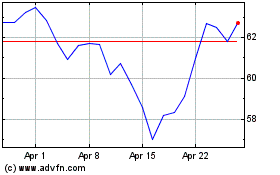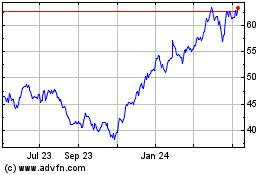Citi's International Business Reveals A New Risk
March 15 2012 - 9:30AM
Dow Jones News
In a delicate process of convincing the Federal Reserve to allow
Citigroup Inc. (C) to reward its shareholders, Citi seems to have
run into a strategic issue: The risk of its global banking
business.
That may make the bank's task to convince the Fed to allow it to
return capital to shareholders more complicated than simply
retaking the Fed's most recent stress test and asking for less
money to be paid out as dividends or used to repurchase shares.
Emerging from the financial meltdown caused in large part by
U.S. mortgages, Citi built a strategy around lending, processing
payments and issuing and trading securities around the world. "We
believe the core strengths and the global footprint of our model
are extremely well aligned with global trends and should give us
higher growth and opportunities than our domestic-focused peers,"
Chief Executive Vikram Pandit told investors only last week. "Feel
free to applaud."
In the Fed's test, which was imposed on the 19 largest U.S.
banks to examine their ability to withstand an economic downturn,
Citi's global strategy seemed to add to the bank's risks rather
than give it a competitive advantage. In calculating potential
losses in a theoretical, severe economic downturn, the Fed put
Citi's losses from souring consumer and business loans much higher
than potential losses at other banks--including Bank of America
Corp. (BAC)--despite Bank of America's struggle with massive losses
from U.S. mortgages made by Countrywide Financial, the consumer
lender it bought early in the financial crisis.
"We suspect the Fed may have treated foreign loans harsher than
domestic ones in its stress test," said analyst John McDonald of
Sanford C. Bernstein & Co. Matthew Burnell of Wells Fargo
Securities also believes that "in this academic exercise,"
international consumer loans, in particular, were Citi's main
weakness.
The Fed said it doesn't discuss the analysis of individual
banks. It disclosed, however, that consumer loan losses were
projected partly based on "borrower characteristics, such as credit
rating or FICO score." Consumer loans outside the U.S. don't have
FICO scores.
But international loans should have less risk, said Sandler
O'Neill + Partners analyst Jeffery Harte. Citi makes loans mostly
to affluent clients abroad, who default less often, and mortgages
outside the U.S. are less risky because banks often can claim more
assets than just the house in case of default.
Still, many analysts and even some rival bankers believe Citi
asked for too much, given the Fed's apparent risk tolerance. "When
we went into this, we said, 'this is a pass-fail test that you
can't afford to fail, so you can't get greedy," one executive at
another bank said. "The (Fed's) numbers make absolutely no sense to
us. I am sure other people felt the same and thought they have a
mile of room" in how much they can pay out as dividends or use to
buy back shares.
All last year, Pandit was confident that 2012 would be the year
Citi would reward shareholders. "We have the capacity to begin
returning capital this year," Pandit reiterated last week. Shares
of Citi had fallen from about $55 in 2007 to just under $1 in the
thrust of the financial crisis, but Citi did a reverse split and is
now trading around $35. It had stopped paying a dividend and last
year was approved by the Fed to pay a 1 penny dividend.
Several analysts believe Citi asked to return $10 billion to
shareholders through share buybacks and a dividend increase--a high
amount given Citi's risk-based capital. Given the sensitivity of
the test, Citi's actual payout request was likely lower. Sandler's
Harte said Citi more likely asked for around $3 billion.
The question now is, how much can investors expect? Citi said it
will submit a new test "later this year" and "we plan to engage
further with the Federal Reserve to understand their new stress
loss models."
Hart said he expects Citi to ask for about $1.5 billion, and
Wells Fargo's Burnell said he expects Citi might ask for $2.5
billion. But if the Fed's issue is with Citi's risk profile rather
than the amount of money it asked for, some analysts think there
might not be any payout this year.
"It feels like the Fed wants Citi to wait," Sanford's McDonald
said. "Is it about needing another year to prove itself to the
Fed?" Chris Kotowski of Oppenheimer & Co. too believes "it just
seems as though this is the Fed's way of saying, 'This is not your
year.'"
-By Matthias Rieker, Dow Jones Newswires; 212-416-2471;
matthias.rieker@dowjones.com
Citigroup (NYSE:C)
Historical Stock Chart
From Jun 2024 to Jul 2024

Citigroup (NYSE:C)
Historical Stock Chart
From Jul 2023 to Jul 2024
